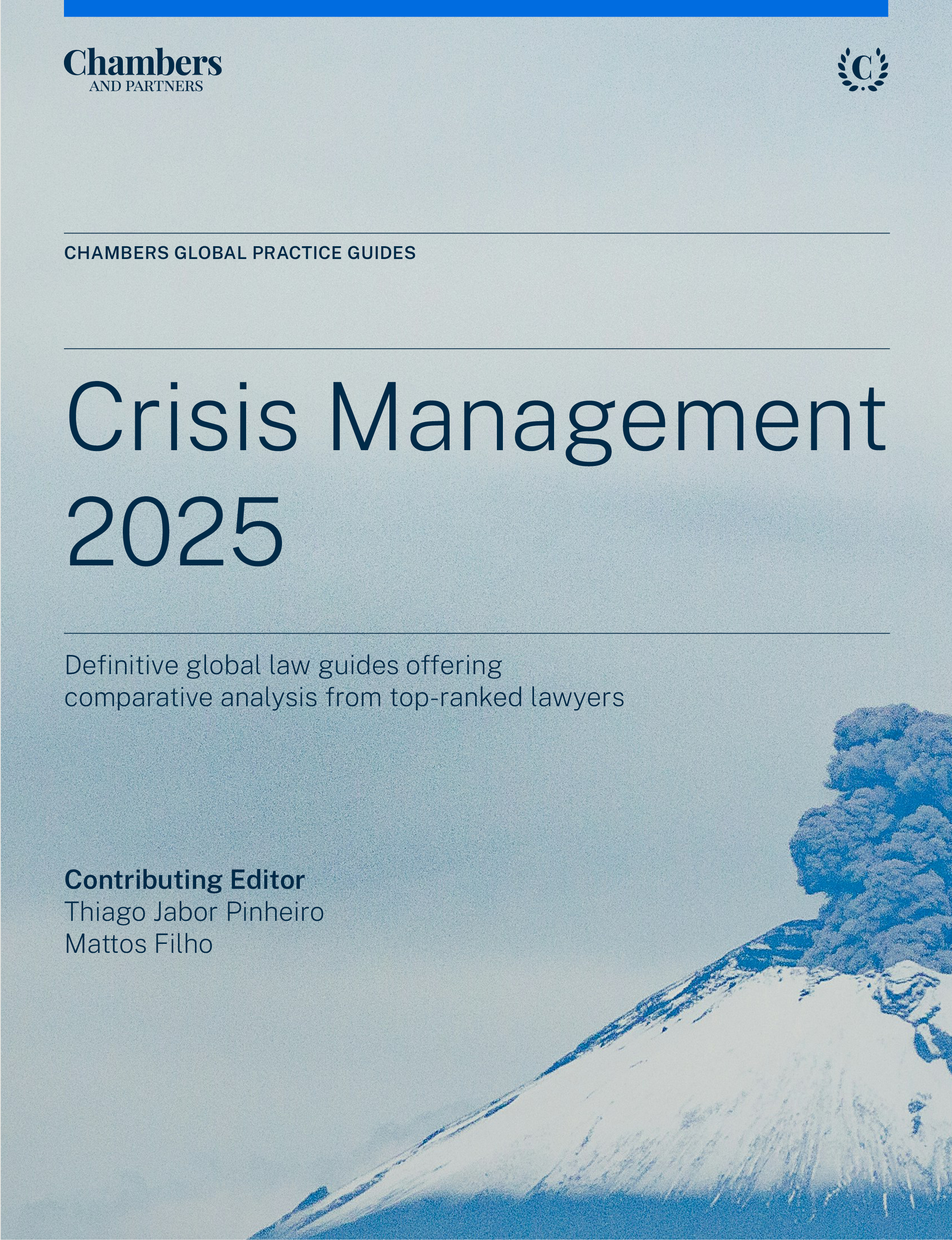
Crisis Management 2025
The new Crisis Management 2025 guide features a dozen key jurisdictions. The guide provides the latest information and communications advice on the key sectors impacted by crises; the legal and regulatory framework for crisis management, including the role of the state; corporate crisis management, including crisis management plans and the role of external advisers; preventing and/or mitigating crises; communications strategy; and post-crisis review.
Last Updated: March 26, 2025
Compare law and practice by selecting locations and topic(s)
Select Locations

Select Topic(s)

Please select at least one location and one topic to use the compare functionality.
Crisis Points: A Global and Historical Overview of Crisis Management as It Continues to Unfold
Corporate crisis management has evolved significantly in recent decades, driven by changes in the environmental, social, political, economic, and technological challenges that businesses face on a global scale. Historically, crisis management primarily focused on responding to threats and mitigating their impact, whereas a more modern approach considers a broader spectrum of concerns (including risk assessment and prevention, preparedness and response, recovery and remediation).
This evolution has also reshaped the expectations of companies regarding the roles of the outside experts they seek out when a crisis hits. Companies now resort to a growing and diverse range of crisis specialists, including lawyers in different practice areas, technical experts, communications advisers, cybersecurity and IT consultants, private investigators, remediation designers, and several others. All these professionals must work seamlessly together with the company’s crisis management team to help the company face the complex and constantly evolving issues that often arise during a crisis.
The decision by Chamber and Partners to launch a practice guide dedicated to crisis management is, therefore, both important and timely. This guide brings together contributions from a stellar group of leading professionals from various backgrounds, fields of expertise, and jurisdictions to offer readers – particularly corporate leaders – a comprehensive resource to help their organisations understand and manage the complexities of modern-day crises.
Crises management from a historical perspective
Corporate crises can be defined as unexpected events arising from a company’s business activities that pose substantial, or even existential, risks to both the company’s continuity and reputation and the communities it serves. As such, corporate crises are inevitably linked to economic cycles and the development and emergence of new business sectors, activities, and markets. As businesses evolve, so do the crises they may face.
During the dawn of the Industrial Age, from the late 1800s to the early 1900s, corporate crises often stemmed from dire labour conditions, the spread of smoke and fog due to rudimentary industrial methods, and infrastructure failures. Innovations in banking and securities in the early 1900s brought crises related to financial misconduct and bank runs. The 1950s, for example, saw the first large-scale corporate crises in the pharmaceutical, chemical, and transportation sectors.
The early days of globalisation in the 1970s and 1980s introduced crises related to unethical business practices in less developed nations and significant oil spills. In the 1990s and 2000s, crises related to accounting and corporate fraud became more common. More recently, in the 2010s and 2020s, crises have emerged from cybersecurity failures, serious workplace misconduct, and growing concerns about the impact of business activities on the climate.
Evolving types of crises and crisis management
This is not to say, of course, that crises that happened in the past cannot happen again. Unfortunately, recent examples demonstrate that virtually all the above-mentioned types of crises continue to have disastrous consequences for the communities and the environment in which affected companies operate. However, today’s interconnected world introduces a remarkable novelty: crises can now emerge from a far more diverse range of sources, evolve much faster in scale and reach, and have a much broader impact.
At the same time, the expectations of stakeholders – including regulators and communities – have evolved regarding the degree of care and responsibility that corporate leaders are expected to take and the ethical standards that they are expected to follow. Regulators have developed new legal and practical tools to respond to crises and hold companies and individuals accountable. Communities now have more resources to raise awareness and seek redress. Consequently, companies are held to a much higher standard than ever before, requiring a broader perspective for their crisis prevention and management practices as well as their mitigation and remediation efforts.
Cross-border crises and geopolitical tension
Another complicating factor is the cross-border potential of certain crises. A crisis event that happens in Brazil, for example, can very easily generate impacts, investigations and litigation in other jurisdictions, as regulators and communities have deeper connections and the ability to reach beyond territorial borders. All of this occurs in a time of increasing geopolitical tension, presenting an additional challenge for organisations that operate in several jurisdictions.
In some parts of the world, political instability, disputes concerning immigration and foreign trade, and decreased trust in multilateral organisations and negotiations can also disrupt supply chains, affect market stability, and pose security risks – creating additional complexity for those whose job it is to ensure that a global business remains stable. The German chapter by Wilke, Theusinger and Schilla in this guide exemplifies how both the local and global political landscape can affect crises and their management.
Technological challenges
Technological progress and the reliance on data have increased companies’ exposure to IT threats that could have unpredictable effects and lead to serious corporate crises. Data protection is a significant modern concern for companies and the rise of cyberthreats makes privacy an increasingly important issue.
Data breaches and cyber-attacks can have dramatic effects and consequences may range from legal penalties to the loss of trust from customers and counterparties. Recent high-profile data breaches highlight the importance of cybersecurity policies and protections in crisis prevention.
In their insightful contribution to this guide, Singer and Griffanti discuss the complexity of cybersecurity crises and the importance of managing the expectations of various stakeholders. In the USA – Illinois chapter, the authors discuss the role of the media in shaping public perception of privacy and safety. In the USA – Washington, DC chapter, Marlin, Becker, McQuillen and Pulio-Deighton emphasise the critical importance of comprehensive risk assessment and preparation for cybersecurity crisis response. They argue that commitment from management is indispensable in successfully addressing the impact of cyber-incidents.
Climate change
For some time, climate change has been an emerging source of crisis as companies and communities adapt to its risks and consequences. Organisations are under increasing pressure to adopt sustainable practices, reduce their carbon footprint, address climate-related risks associated with their activities, and comply with new regulatory requirements on industry standards. In the Australian chapter, Briggs, Wong, Smyth and Dougherty touch on this topic, discussing examples of the increasing complexity of Australian regulatory and enforcement scenarios concerning environmental issues during the past few years.
The failure of an organisation to adequately address those risks can lead to regulatory enforcement, pressure from investors, and reputational damage – all in an ever-changing environment. Therefore, effective management of this type of crisis requires science-based decision-making, transparent reporting, and proactive stakeholder engagement. It also requires adequate climate risk assessments, which are essential to build climate resilience and better response mechanisms.
Diversity, equity, and inclusion (DEI)
In recent years, diversity, equity, and inclusion have become critical sources of potential crises. While different jurisdictions may adopt different approaches and requirements as to the extent of the adoption of such practices by companies, there is increasing accountability and demand for inclusive cultures, equitable policies, and transparent communication. Workplace harassment and discrimination are serious threats to the well-being of employees and communities; organisations need to respond accordingly.
Speed of the modern news cycle
Crisis management professionals in the 1950s could go to bed after the evening news and only worry about the following day’s morning papers. Nowadays, such professionals can barely be away from their phones for a few minutes as a crisis develops. The pace of the modern-day news cycle and the ability for information to instantly spread have significantly increased the pressure on organisations and their advisers. With the rise of social media and digital platforms, information can become global within minutes, requiring a more agile, proactive approach.
This has also amplified public scrutiny and demands for accountability. Crises can have a more profound and immediate impact on an organisation’s reputation, as negative news can quickly go viral and disrupt a company’s operations in several jurisdictions at once. In this scenario, organisations need to be prepared to engage in real-time communication, monitor media coverage, and address stakeholder concerns promptly.
By examining US trends in crisis management, the chapter by McAndrews, Wachter, Kimberly, and Pickler discusses the impact of media fragmentation and the consequences of eroding public trust in the media and the professional press for organisations. The authors recommend practices to ensure an effective crisis response on that front, which include ensuring that the organisation’s message is consistent and clear. The ability to provide timely, accurate and appropriate updates to stakeholders ‒ demonstrating a commitment to resolving the crisis ‒ may determine whether an organisation is able to survive. Miscommunication during a crisis can easily become another crisis.
Adaptability and resilience
As we delve into the complexities of crisis management in this guide, we want to highlight the importance of planning, adaptability, and resilience. By working in advance to understand what may lead to or amplify crises and by implementing robust prevention and management frameworks, organisations can enhance their ability to respond effectively and mitigate potential risks to themselves and the communities they impact.
As analysed by Sá in the Brazil chapter, adopting a preventive strategy and building strong relationships with governmental authorities is crucial for companies to reduce legal exposure and confusion during a crisis. Maintaining a consistent communication strategy is key to preserving credibility, especially during the initial stages of a crisis.
This involves developing a culture of ongoing improvement, which includes being able to learn from past crises to avoid new ones. A good example comes from crisis response tabletop exercises, which are discussed in the USA – New York chapter by Roberts and Griffanti in this guide.
Conclusion
With this introduction, we hope to set the stage for the following chapters of this Global Practice Guide. By understanding the historical context, the evolving types of crises, and the modern challenges posed by technological threats, climate change, DEI issues, and the rapid pace of the news cycle, corporate leaders can better prepare for the complex landscape of crisis management.
As mentioned earlier, the goal of the editorial team is to equip corporate leaders with the knowledge and tools they need to anticipate, prepare for, and respond to crises in different jurisdictions. In doing so, their ability to safeguard their organisations and the communities they impact will increase.


